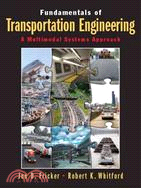| FindBook |
有 1 項符合
Fundamentals of Transportation Engineering: A Multimodal Systems Approach的圖書 |
 |
Fundamentals of Transportation Engineering: A Multimodal Systems Approach 作者:Jon D. Fricker 出版社:新月文化 出版日期:2004-03-01 |
| 圖書館借閱 |
| 國家圖書館 | 全國圖書書目資訊網 | 國立公共資訊圖書館 | 電子書服務平台 | MetaCat 跨館整合查詢 |
| 臺北市立圖書館 | 新北市立圖書館 | 基隆市公共圖書館 | 桃園市立圖書館 | 新竹縣公共圖書館 |
| 苗栗縣立圖書館 | 臺中市立圖書館 | 彰化縣公共圖書館 | 南投縣文化局 | 雲林縣公共圖書館 |
| 嘉義縣圖書館 | 臺南市立圖書館 | 高雄市立圖書館 | 屏東縣公共圖書館 | 宜蘭縣公共圖書館 |
| 花蓮縣文化局 | 臺東縣文化處 |
|
|
- 圖書簡介
Combining topics that are essential in an introductory course with information that is of interest to those who want to know why certain things in transportation are the way they are, the book provides a strong emphasis of the relationship between the phases of a transportation project. The volume familiarizes readers with the standard terminology and resources involved in transportation engineering, provides realistic scenarios for readers to analyze and offers numerous examples designed to develop problem solving skills. The volume examines transportation basics, traffic flow theory and analysis, highway design for performance, modeling transportation demand and supply, planning and evaluation for decision-making, design of highway for safety, design of intersections for safety and efficiency, pavement design, public mass transportation, air transportation and airports and environmental issues/emerging technologies. For those interested in transportation engineering.
- 作者簡介
Prof Robert Whitford holds B.S., M.S. and Ph.D. degrees in electrical engineering from Purdue University. Following graduation in 1955, he worked in the aerospace industry, designing and analyzing Missile and Spacecraft systems at TRW Systems (Redondo Beach, California) for 17 years. The last six years at TRW he served as Operations Manager for Guidance and Control (3 years) and Advanced Electronic Systems (3 years). He then became deeply involved in the systems and design aspects of multimodal transportation while serving 6 years as Deputy Director at what is now the US DOT's Volpe National Transportation Systems Center in Cambridge. He joined the automotive transportation-energy research team at Purdue in 1980. In 1982 he began serving as part-time director of Purdue's Public Policy Center, while teaching large scale systems and freight/logistics courses in both civil and industrial engineering. He became full-time on the Civil Engineering Faculty in 1989. In addition to his research interests highway congestion management, logistics systems, and air transportation, he has taught graduate courses in transportation planning, transportation project evaluation, urban planning, and airport planning and design. He was the coordinator of the capstone civil engineering design course for five years. He retired from the Purdue faculty in January 2002 and now lives in Alaska, working part time for the Alaska Department of Transportation.
Prof. Jon Fricker received the S.B.C.E. degree from the Massachusetts Institute of Technology and the M.S.C.E. and Ph.D. degrees from CarnegieMellon University. His degrees all came from civil engineering programs that required a solid grounding in all facets of CE. Since joining Purdue's Civil Engineering faculty in 1980, his principal teaching and research interests have been in transportation planning, public mass transportation, and urban planning. Prof. Fricker's service on the local bus company's Board of Directors and the county's Technical Transportation Committee has been a source of many reality-based problems for homework and in-class use.
Professors Whitford and Fricker have interests that overlap in urban planning, economic analysis, and systems analysis. In areas where neither of them had a strong background, they have worked to become competent by attending short courses and seeking the advice of experts. Because their backgrounds are somewhat different, they complement each other well. More importantly, they are in close agreement about what an introductory course in transportation engineering should include and how it should be presented. They think that their ideas, reflected in this textbook, will find acceptance among others teaching a similar course.
|










